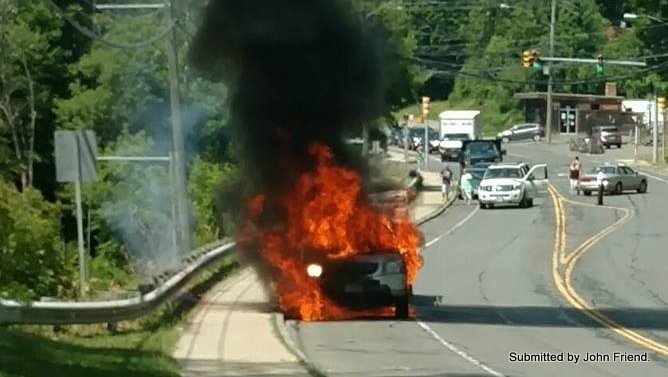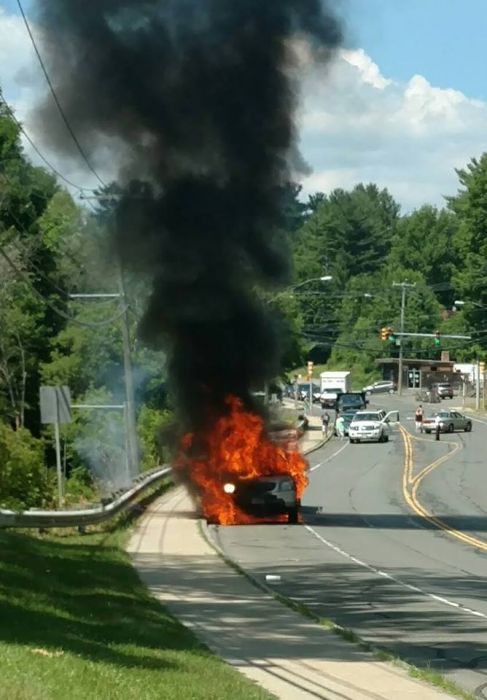| Home | About | Archives | RSS Feed |

Vehicle Towing Boat Catches Fire Near Pontoosuc Lake


Reader John Friend submitted this photo of the blaze.
Deputy Fire Chief Mark Cancilla said he and six firefighters from two engines responded to Upper North Street, near Pontoosuc Lake between Zucchinis Restaurant and Hancock Road, shortly after 2:30 Wednesday to find a Honda Pilot towing a boat fully involved.
Firefighters blocked off the road and ran two hose lines to extinguish the blaze in just 15 minutes — quick enough to save the pontoon boat from further damage.
"It was a hot fire. It damaged the pavement," Cancilla said.
The occupant had gotten out of the SUV and escaped injury and no firefighters were harmed. Traffic was detoured over Hancock Road for about a half hour while the firefighters worked in temperatures approaching 90 degrees.
"It probably wasn't more than 15 minutes to put it out. It was great teamwork, especially in this hot weather," Cancilla said.
The front seats on the boat had begun to melt and catch fire when firefighters arrived, but the crew was able to halt any further damage.
"We saved the boat," Cancilla said.
Cancilla said it appears that the fire started when the trailer hitch broke and jammed into the rear wheel of the Pilot. The spark led to the fire — possibly fueled somewhat by a leak in the transmission line.
The Department of Environmental Protection was called in because a storm drain nearby goes into the river. Cancilla said firefighters plugged the drain up in hopes of preventing any contaminants from finding its way in.
The National Highway Traffic Safety Association provides the following tips for towing trailers.
General Handling
- Use the driving gear that the manufacturer recommends for towing.
- Drive at moderate speeds. This will place less strain on your tow vehicle and trailer. Trailer instability (sway) is more likely to occur as speed increases.
- Avoid sudden stops and starts that can cause skidding, sliding, or jackknifing.
- Avoid sudden steering maneuvers that might create sway or undue side force on the trailer.
- Slow down when traveling over bumpy roads, railroad crossings, and ditches.
- Make wider turns at curves and corners. Because your trailer's wheels are closer to the inside of a turn than the wheels of your tow vehicle, they are more likely to hit or ride up over curbs.
- To control swaying caused by air pressure changes and wind buffeting when larger vehicles pass from either direction, release the accelerator pedal to slow down and keep a firm grip on the steering wheel.
Braking
- Allow considerably more distance for stopping.
- If you have an electric trailer brake controller and excessive sway occurs, activate the trailer brake controller by hand. Do not attempt to control trailer sway by applying the tow vehicle brakes; this will generally make the sway worse.
- Always anticipate the need to slow down. To reduce speed, shift to a lower gear and press the brakes lightly.
Acceleration and Passing
- When passing a slower vehicle or changing lanes, signal well in advance and make sure you allow extra distance to clear the vehicle before you pull back into the lane.
- Pass on level terrain with plenty of clearance. Avoid passing on steep upgrades or downgrades.
- If necessary, downshift for improved acceleration or speed maintenance.
- When passing on narrow roads, be careful not to go onto a soft shoulder. This could cause your trailer to jackknife or go out of control.
Downgrades and Upgrades
- Downshift to assist with braking on downgrades and to add power for climbing hills.
- On long downgrades, apply brakes at intervals to keep speed in check. Never leave brakes on for extended periods of time or they may overheat.
- Some tow vehicles have specifically calibrated transmission tow-modes. Be sure to use the tow-mode recommended by the manufacturer.
Backing Up
- Put your hand at the bottom of the steering wheel. To turn left, move your hand left. To turn right, move your hand right. Back up slowly. Because mirrors cannot provide all of the visibility you may need when backing up, have someone outside at the rear of the trailer to guide you, whenever possible.
- Use slight movements of the steering wheel to adjust direction. Exaggerated movements will cause greater movement of the trailer. If you have difficulty, pull forward and realign the tow vehicle and trailer and start again.
Parking
- Try to avoid parking on grades. If possible, have someone outside to guide you as you park. Once stopped, but before shifting into Park, have someone place blocks on the downhill side of the trailer wheels. Apply the parking brake, shift into Park, and then remove your foot from the brake pedal. Following this parking sequence is important to make sure your vehicle does not become locked in Park because of extra load on the transmission. For manual transmissions, apply the parking brake and then turn the vehicle off in either first or reverse gear.
- When uncoupling a trailer, place blocks at the front and rear of the trailer tires to ensure that the trailer does not roll away when the coupling is released.
- An unbalanced load may cause the tongue to suddenly rotate upward; therefore, before un-coupling, place jack stands under the rear of the trailer to prevent injury.

